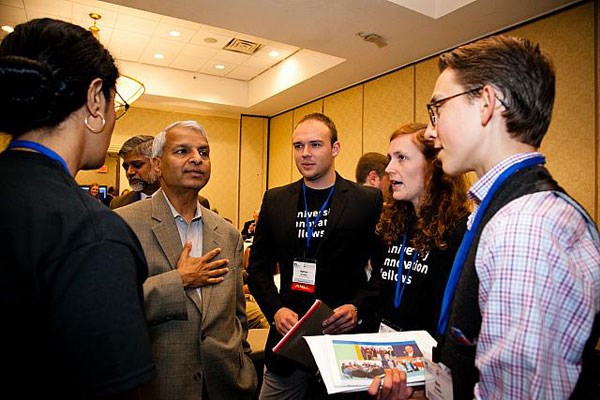Deshpande Symposium Focuses on Innovation in Higher Ed

06/18/2015
By David Perry
Subra Suresh already had the crowd hooked by the time he tossed out an example of America’s characteristic tenacity when challenged.
“We put a man on the moon before we put wheels on a suitcase. Americans do very well when there is a target to shoot for,” Suresh told attendees at the fourth annual Deshpande Symposium for Innovation and Entrepreneurship in Higher Education at the UMass Lowell Inn & Conference Center.
Suresh, president of Carnegie Mellon University and former National Science Foundation director, could have dropped the microphone there. But in 45 minutes of his keynote address, he gave hundreds of folks attending the conference plenty to chew on, including historical perspective on boosting science funding during tough times (Abraham Lincoln did it twice).
“It’s what great leaders do,” Suresh said.
The conference, launched three years ago and co-founded by UMass Lowell and the Deshpande Foundation, drew more than 300 people from more than 100 institutions across the U.S. and from as far as Africa. Attendees shared a yearning to accelerate innovation and entrepreneurship at their colleges and universities.
“The great thing about this conference,” said UMass Lowell Executive Vice Chancellor Jacqueline Moloney, “is that in this room, we are all kindred spirits.” Moloney said that risk and loneliness is a bond they share, as well as paths through which success often travels.
The symposium fell during a particularly fruitful week for innovation and entrepreneurship in Lowell, as symposium attendees had a first look at the UMass Lowell Innovation Hub and the expanded Massachusetts Medical Device Development Center (M2D2) in the 110 Canal building in Lowell’s Hamilton Canal District. In all, the two operations offer 22,000 square feet on two floors of a former mill, providing medical device and tech startup businesses and entrepreneurs research space and expert assistance.
Speeding up the Glacial Pace of Change
“I’m really impressed with everything I’ve seen,” said first-time attendee Misty Stutsman, manager of Events and Outreach at the Riata Center for Entrepreneurship at Oklahoma State University’s Spears School of Business. She was one of six attendees from Oklahoma State. “We’ve been to conferences before, but when I saw this one, I figured, that’s a perfect fit.”
James Spencer Jr., executive director of Rensselaer Technology Park, Real Estate and New Venture Development at Rensselaer Polytechnic Institute, said he attends several entrepreneurship conferences every year but finds the Desphande Symposium to be the best.
“This one is my favorite,” he said.
Attendees heard about successful strategies for cultivating innovation on campus and, through panel discussions, learned from each other. Between keynotes, there was a packed schedule of panels, workshops, an awards dinner, and a constant undercurrent of networking.
As more than one speaker noted, institutional change at colleges and universities can come at a glacier’s pace.
“We’re looking to expand our technology and entrepreneurship and this just feels like a very thirsty group. Not like a social conference, but one where everyone is there to look for answers. Like, ‘hey, I know you’ve already had some experience with this. Can you help me over here?” said Stutsman.
She borrowed a term to describe fruitful meetings – “collisions” – used by Boston University’s Vinit Nijhawan in a panel discussion dubbed, “Telling the story of Innovation & Entrepreneurship.”
“There are a lot of collisions going on here,” Stutsman said. “Serendipitous meetings, people helping one another, sharing experiences.”
The conference-closing keynote speaker, Priceline.com co-founder Jeff Hoffman, was a dynamo, an enthusiastic, fast-speaking dam-burst of information. Or, as he called it, “one long paragraph with no punctuation.”
The man, whose Priceline.com company is now worth $62 billion, challenged educators to give their charges the tools to make things happen. He is just coming off three years of “a giant research experiment” where he took students on a ship around the world, and answered every appeal for help that came his way.
They were “the best years of my life, easily,” said Hoffman, who long ago rejected tradition for the “crazy and unreasonable.”
Hoffman summed up entrepreneurship like this: “Being an entrepreneur is like jumping off a cliff and designing an airplane on the way down.”
This is the guy who once stood in an airport check-in line for 58 minutes only to have the airline worker issue his boarding pass in an instant.
“I just stood in line for an hour for that?” he said.
The next day, he formed the venture that would invent stations to do the job.
“I sold that company for $100 million,” he said. “Not bad for a twenty-something-year-old.”
The symposium is also one of the few places where failure is not whispered as a sin, but considered a necessary step toward success.
“Only when you are between a rock and a hard place do you find the solution to a problem,” said Gururaj “Desh” Deshpande, the veteran entrepreneur, founder of several companies and symposium namesake. He was introducing Suresh.
“Unfortunately, universities can get cast in concrete,” he said. “Change is very hard.”
Not so for Suresh, who earned his Ph.D. in two years from MIT, said Deshpande. “This is a man in a hurry.”
So is Carnegie Mellon. Last year, Suresh said, 38 companies, most staying in Pittsburgh, were spun out from the university’s entrepreneurs.
The former steel city “is literally cleaning itself up through innovation and entrepreneurship,” and new technology and business models.
So why is it important to fund innovation and entrepreneurship, he asked?
He told a story with a famous quote attributed to Michael Faraday, an English chemist and physicist who met with English Prime Minister William Gladstone to obtain funding for his electromagnetic device.
“Why should the British taxpayers fund your curiosity?” asked Gladstone, according to the story.
“Because one day,” Faraday reportedly answered, “you will be able to tax it.”
